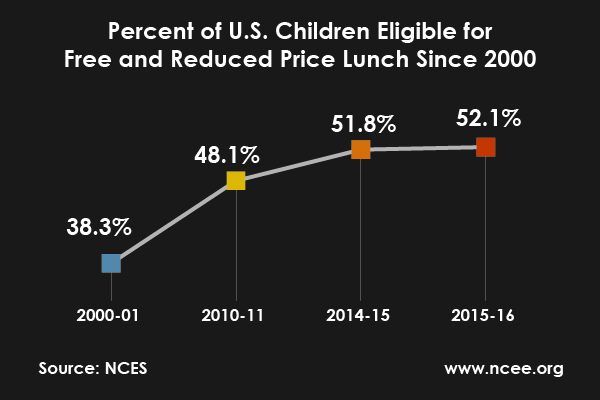Regular readers of this blog know that I frequently point out that the United States spends a lot more per student than the countries with the best student performance. But you may have also noticed that, in the same breath, I am quick to point out that the level of child poverty in the United States is much higher than in those other countries.
Now we have from The Economist, in a recent issue, a multi-part special section on poverty in the United States. I want to share some of the highlights that focus on child poverty.
Both the standard measure of poverty and the Supplemental Poverty Measure (SPM), which takes benefits and cost of living into account, show that about one in six children in the U.S. is poor. (The current official poverty level is $25,750 for a family of four.) While there are poor families all over the country, the averages are misleading, because the poor are usually concentrated in clusters.
When educators think about poverty among their students, the measure that comes first to mind is the percentage of public school students eligible for free and reduced-price lunch, which is available to children in households with incomes at or below 185 percent of the federal poverty level. In the 2000-01 school year, 38.3 percent of public school students were eligible. That figure climbed to 48.1 percent in the 2010-11 school year, 51.8 percent in the 2014-15 school year and 52.1 percent in the 2015-16 school year. But these figures, like those for poverty overall, are often far higher where poverty is concentrated and its effects far worse and much longer lasting there.

The Economist points out that, when Jack Kennedy was President and Lyndon Johnson became President, it was different. Then, the poorest among us were the elderly. Now, with the growth in Medicare and Social Security, the elderly are doing much better and the young much worse. The experience of the elderly, however, is instructive. Policy changed the outcomes for them dramatically. There is no reason why that should not be equally true for the young. What is most interesting about The Economist’s article on child poverty is not the statistics, which are well known. It is their comments on the policy options for dealing with the problem of child poverty in the U.S.
The simplest solution is cash transfers. The Economist refers to the work of Stanford professor David Grusky, who calculates that California could end child poverty in that state by spending only $2.8 billion a year, one quarter of what it spends annually on its prisons. Conservatives often oppose cash transfers to poor people on the grounds that they stifle initiative. But we could probably all agree that transfers for young children will not destroy their initiative. Many first-world countries in Asia, North America and Europe award means-tested and non-means-tested allotments to families with young children, especially countries where the domestic fertility rate is falling below the birth rate. The Economist quotes Jane Waldfogel, a Columbia economist, saying that a relatively small universal child credit could cut the U.S. child poverty rate in half all by itself.
But, says The Economist, the problem cannot be dealt with solely with a transfer program, because poverty in the U.S. is so concentrated. Researchers have shown that young children who are doing very poorly in schools serving students in concentrated poverty do much better if they can go to schools serving families in wealthier communities. Those other communities don’t necessarily have more money per student, but they provide much more support to the student in the form of higher expectations, a wider range of experiences and more rigorous schooling. While this strategy is not fully scalable, it could certainly be ramped up.
In this vein, we note that Howard County, Maryland, recently redistricted its schools to allow many more children whose schools were made up of large numbers of students in concentrated poverty to go to schools with wealthier children and spread the number of children in poverty more equitably across that district. They did this because their own research showed that earlier efforts to do this same thing worked to lift performance in students who come from impoverished backgrounds.
Many of the schools that are economically segregated are also racially segregated. The Economist points to data showing that moving students from racially segregated schools to unsegregated schools can, over five years, improve student incomes by 30 percent and greatly reduce the likelihood of incarceration. But, just as poverty is rising among school children, our schools are becoming more, not less, segregated.
In the early days of desegregation, inner-city predominantly African-American school districts were merged with predominantly white ones into a single district. But, in recent years, white, relatively well-to-do areas within large urban districts have been applying to their state legislatures for the right to form their own school districts, or, failing that, their own cities or towns (which would enable them to get their own school district), thereby contributing to the isolation and concentration of low-income, often minority, families in communities where hope for a better future is dying.
The Economist article ends with a reminder of Daniel Patrick Moynihan’s warnings, back in the Nixon administration, about trouble in the African American family. Around a quarter of African Americans then were born out of wedlock. That proportion is now 70 percent for African Americans, 50 percent for Hispanic children and 30 percent for whites. The proportion for poor whites living in poverty is, of course, much higher. Research shows that households with single parents are more likely to live in poverty and the children in those families are more likely to experience lower academic achievement than households with two parents. When critics insist that American teachers need to be held accountable for the poor performance of American school children, the teachers shoot back that they are being held accountable for the failure of American parents and taxpayers to take care of their children.
When some of us point out that there has been no improvement in the performance of all high school students or of protected subgroups of students in the United States on NAEP measures of reading and mathematics in 30 years, they tell us we should consider ourselves lucky that we have teachers who have been able to hold student performance steady while the American people have been sending them students who get poorer and more isolated every year.
I think they have a point. Don’t you?
I began this blog by pointing out that the U.S. spends much more per student on our schools than the countries with the best education performance. But it is also the case that other countries, with higher student performance and lower school spending per student, have smaller disparities in income between their wealthiest families and their poorest ones, and despite that, spend much more than we do on the support of families with young children on everything from child allowances to child care and early childhood education. From my vantage point, our budgets for children, families and schools, if you take everything into account, do very little about the enormous problems caused by concentrated poverty and racial segregation and then load all the problems that causes onto the schools.
Back in the day, we used to make cars with the same philosophy. Our big auto makers paid very little attention to quality during the whole process of making cars. The result was a big pile of wasted parts and ill-made cars at the end of the assembly line, which either had to be rebuilt or thrown away at great cost. In the 1980s, the Japanese, listening hard to American quality experts who had not been able to get a hearing in the United States, built quality control in from the front end of the assembly line to the end. The result was virtually no waste at the end. It turned out that the cost of the waste in the American system was more than the cost of building quality in from the beginning. Hence the mantra of the quality experts: ‘The cost of quality is nothing.’
That was forty years ago. Don’t you think it is time to do for our children what the Japanese taught us to do for our cars? It is a whole lot cheaper to do right by our children starting when mom is pregnant than it is to wait six years, when it is a whole lot harder to do what must be done to give these kids a chance in a world in which the skill threshold for earning a decent living is getting higher and higher.





